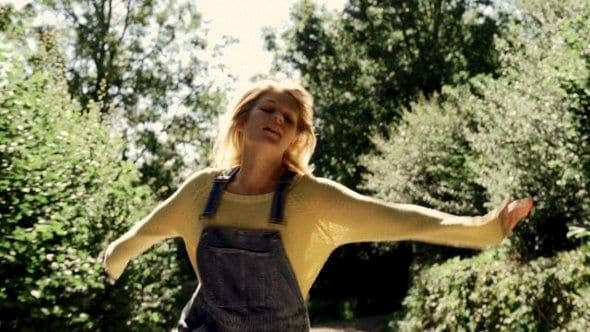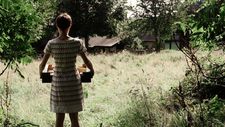 |
| Hide And Seek |
When one first reads the introduction to it in the Edinburgh International Film Festival brochure - two young couples move in together... engaging in scheduled partner swapping - Hide And Seek sounds like another sex film, an excuse to draw in lazy film critics with the promise of flesh and hopefully create a bit of scandal that will attract the public. In fact it’s something very different and a good deal more important. Speaking to director Joanna Coates I put it to her that one of the film’s strengths is that it seems informed – not simply fantasy but a properly researched picture of how multiple-partner relationships can develop.
“I think that there’s two things to do with that,” she responded. “You’re right. The film has more of an allegorical aspect looking at love and sex and the limits that we place on how we express ourselves in that way. Rather than the kinky idea of threesomes it’s about exploring monogamy and the problems with that fantasy idea of changing how we approach relationships but not hurting people. It’s about love and loneliness.”
Threesome are something people do for fun, she notes, but she wanted to look beyond recreational sex at the ways people deal with falling in love and the hurt that can develop when things change. There’s a social conflict, she suggests, between the idea that everyone should have lots of experiences and the idea that we should all be in conventional relationships.
In the film, she also wanted to talk about the eventual ordinariness of all relationships. “Whatever ideology you have it always becomes practical... Even if you’re moving into an apparently different way of living, you have to create rules and structures for that. I tried to zero in early on the fact that there’s humour in it, in that if you tell people to let go then they can’t. They need that process.
I ask if she thinks that there’s a difference in her work because these stories are usually told from a male perspective in films directed by men.
“Yeah. I think there is,” she says. “It’s often framed as either just really decadent or a crisis in a woman’s life that they decide to live differently. I wanted it to be about useful exploration... it’s more about how i see people behaving and feeling. In these accounts there’s usually tha question about what about having children. Of course that does matter to many women but I think it’s good for women to see stories about women doing stuff that doesn’t involve that conversation we’re supposed to be having.”
Female desire is also an important element in the film. Joanna says that for her this was simply part of reflecting reality. This extends to explicit shots of male characters which, I note, made them look vulnerable in a way audiences are not used to seeing. I ask if she was worried that those shots would make it difficult to get the film past the BBFC.
“My concern was to have those shots in there. It’s really important to me because it’s about, well, what people call the female gaze but really it’s just about evening the playing field. I find it aesthetically interesting and erotically interesting. It’s important that we don’t bow down to the idea that we can’t see that. The female naked body we’re used to seeing and male ones we’re not. We’re so used to seeing naked women that we’ve stopped understanding what it does to our perception of that person, so when we see it on a man we’re more aware that our image of that person is being changed.”
Since the film is so strongly character-based, I ask if she had particular actors in mind when she wrote it, and to what extent she was involved in casting.
“My producer and I cast it,” she says. “We had the male characters in mind from the start for people we knew and I wanted to work with them. One has a professional acting background and one doesn’t. Rea [Mole, who plays Leah] is a friend of mine and the actress who plays Hannah came through auditioning. We were all open to exploring and developing the characters through rehearsal and workshopping.”
 |
| Hide And Seek won the Michael Powell award |
They spent a month together working on this in a suburban house, with each actor contributing ideas to his or her character and exploring ways that character might develop. In the end, the dialogue in the film was semi-improvised to give it a more natural feel.
So were they really in the middle of nowhere during filming? I ask.
“We were so isolated!” Joanna exclaims. “I don’t think it’s possible to be more isolated in the UK. We were in this English-Welsh mountain valley with the whole cast and crew staying in the house where we were filming. There was no phone reception and the nearest thing you could walk to was a pub about two miles away.” It was tough to shoot in this situation, she says, but it added immensely to the resulting film.
Some of the tension in the film, I suggest, comes from the difference between the imagined idyll and the often mundane reality of the countryside, which mirrors the protagonists’ relationships. I was impressed by the way the sometimes very flat photography contributed to this.
“I was the thinking was that we wanted a kind of dreamy or very slightly otherworldly sense to infuse the film but it had to be spiked with reality,” Joanna agrees. “I like talking about and looking at English landscapes because I think they’re really undervalued. They can be menacing, bare or sublime. Those interesting moments of flatness were important to have – and huge credit to our cinematographer Ben Hecking – having it looked like a sun soaked idyll all the time wouldn’t work. The story was seasonal and we did try and match with arriving in springtime, things developing in summer and then going into autumn as things change. I have found in my own life that there are these patterns of behavior that change with the seasons, like being more excited by new things in springtime.”
Reflecting on the film’s screenings in Edinburgh and at the East End Film Festival, Joanna says that she hopes tt will get people talking. “What I’m interested in is film which is really responsive to the current culture, reflective and artful, so naturally I want lots of people talk about it.”
“We’ve got two different feature ideas we’re writing,” she says of her current work with writing partner Daniel Metz. “Then we’re looking to develop what is maybe going to be a TV series. I’m interested in television because it offers interesting ways to reach audiences with strange ideas..
“We’re interested in making films which don’t necessarily fit into the British film mode. I hope there can be more room and understanding for that kind of thing, not gritty realism and not costume drama, more like Joseph Losey, approaching the English landscape in a fun, sexy, weird kind of way. I really hope people respond to that."





















